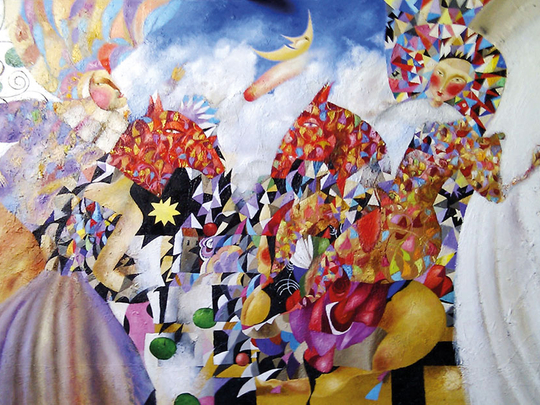
Andakulova gallery is presenting Kaleidoscope, a survey of Uzbek artist Timur Ernst Akhmedov’s paintings created between 2013 and 2018. The exhibition highlights the artist’s love of colour, his versatility and constant search for new ways of expressing himself, and the influence on his work of his travels to different places, including the UAE.
Akhmedov was born in 1968 in Tashkent, Uzbekistan, and knew he wanted to be an artist since childhood. He had a classical Soviet-era art education in Uzbekistan but has continued to experiment with new techniques and styles throughout his career. In the late 1980s, during the era of Perestroika or restructuring in the Soviet Union, he was involved with the experimental Ilkhom theatre, the first independent theatre in the Soviet Union established in 1976.
He came to prominence in the 1990s after winning the Grand Prix at the Asia-Art biennial and became well-known for his post-modernist style. But between 1998 and 2008, he withdrew from the local art scene in Tashkent. He spent a year at Studio Royal Academy in London and collaborated with leading European galleries to hold exhibitions in the UK, Germany and Russia. This international exposure had a huge influence on his style and palette. His collaboration with Dubai-based Andakulova gallery, which began in 2013 and his subsequent visits to the UAE have also led to a new direction in his work.
Surreal, mystical paintings
The most striking element of Akhmedov’s work is the way he uses colour to express emotions, experiences, moods and movement. His inspirations range from his dreams and mythology to his surroundings and modern technology. His work is about finding harmony with his inner self and with the world and his kaleidoscopic, textured paintings have a surreal, mystical quality. They are usually untitled leaving them open to myriad individual interpretations.
Akhmedov often conceives his paintings as diptychs or triptychs, perhaps because of his experience of creating backdrops at the Ilkhom theatre. The elongated, graceful figures in his compositions are always dressed in elegant clothes and dramatic headgear. An example is Northern Song, a triptych from 2013 featuring a flute player wearing a tall pink turban. With eyes closed, the performer appears to be lost in the melody of her own music. Like a mysterious light, music seems to be pouring into the dark painting, with streams of gold, white and shiny blue illuminating the figure, adding depth and drama to the poetic composition.
The mood is different in Days of Apples, a painting filled with splashes of bright colours and joyous figures with wide-open eyes. This painting from 2014 was inspired by the Apple Day festival celebrated in the UK in late October. Held in apple orchards and villages around them, the festival is a fun way of learning about different varieties of apples grown in the country and using them in food, preserves and drinks. Akhmedov’s exuberant painting captures the spirit of the celebrations. It also shows that after living in London and being exposed to contemporary European art he replaced his classical style and dark palette with freer strokes and brighter colours.
The show also includes works from Akhmedov’s iconic series, Connections, which he began in 2015. The series is based on the artist’s belief that we are all connected by invisible threads and depicts couples in romantic, stylised poses. Their closed eyes conceal their feelings but the long, wavy strokes of colour all around them represent the unseen links that bind them together.
In 2016, Akhmedov did a residency at the Art Hub in Abu Dhabi during which he immersed himself in the UAE’s heritage, culture and landscape. The environment inspired him to experiment with abstract art resulting in a series of paintings that convey strong emotions through a play of colours and textures.
Since then he has continued his journey with abstract art working intuitively and with freedom to allow figures to emerge spontaneously from a flurry of colourful brushstrokes. Viewers must spend some time looking at these paintings to discern figures such as a storyteller or a reader and objects such as books, furniture and flowers concealed within the seemingly abstract compositions.
In recent works Akhmedov has played with naïve colours and a naïve unfinished look to comment on our increasingly digital world. His paintings feature amorphous virtual figures floating in space, communication satellites, pixel-like strokes, and lines that mimic a glitch effect.
In other paintings he has returned to his roots, taking inspiration from the figures and floral motifs seen in traditional Suzani embroidery, which was historically used in Central Asia for embroidering maps to help traders navigate their way and is now used to decorate table cloths and wall hangings.
Despite his experiments with contemporary palettes and styles, Akhmedov remains anchored in his classical training. This is referenced in a painting featuring an unfinished female figure alongside a typical studio bust of a man, representing the transience of an artist’s life and the immortality of art itself.
Jyoti Kalsi is an arts-enthusiast based in Dubai.
Kaleidoscope will run at Andakulova Gallery until October 15.












